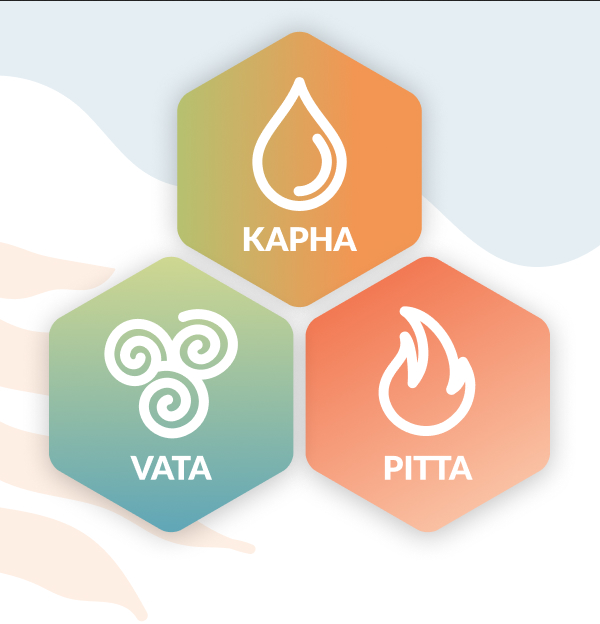Ayurvedic medicine recognizes that health is more than simply the absence of disease. Unlike modern Western medicine, it works to prevent and cure disease as well as to enable people to achieve and maintain ideal mental, emotional, spiritual and physical well-being. It calls upon each individual’s inherent powers of rejuvenation and emphasizes that a person must take an active role in his or her own healing process.

Natural therapies that harmonize with the body and promote its rejuvenating abilities are core Ayurvedic practices and work in concert with an individual’s will to achieve optimal health. These therapies are non-invasive and usually inexpensive. They include diet, physical exercises, breathing exercises, and herbal remedies which are tailored to enhance each person’s unique relationship to the universe.
The Ayurvedic Philosophy
Ayurvedic therapies are based on the philosophy that humans are a microcosm of the universe, that the mind and body are inseparable, and that balance between a person and her/his environment is essential for true health.
Ayurveda, a Sanskrit word meaning the science or knowledge of life, teaches that humans are composed of the same basic elements that comprise everything in nature: ether (space), air, fire, water, and earth. These five elements are the foundation of all matter in the universe, from the smallest dust particle to the farthest planet. They are present not only in our physical surroundings and bodies, but also in our psychological characteristics. Indeed, at the most basic level, our mind and body are inseparable from each other and from the universe as a whole.
Modern science takes pride in its understanding of the human physiology. Yet by focusing only on physiology, it has fostered a fragmented, isolated view of humanity. It has encouraged the perceptions that the body is like a machine; that the mind, body, spirit and earth are separate things; and that external factors, such as bacteria and viruses, are often the cause of disease rather than simply agents of disease able to cause specific symptoms in a susceptible host. This is in stark contrast to the Ayurvedic philosophy of medicine.
According to Ayurvedic philosophy, everything in nature is interconnected. Health is defined as soundness of body, mind, and soul, with these in positive, symbiotic relationship to the natural world. We are complex organisms in constant interaction with the universe, rather than simply machines that can be fixed with a standard tool or formula. In fact, the disease process is different for each individual. It is the result of an imbalance in a person’s unique elemental make-up–a disruption in the spontaneous flow of nature’s intelligence within an individual’s physiology or psychology. Even pathogenic agents only incite disease in one who is out of balance. The goal of Ayurveda, then, is to help each person maintain her/his unique balance of the five elements. Yet these elements continually shift in response to the environment.

Ayurvedic Elements- The Doshas
As described above, everything in nature is comprised of ether, air, fire, water, and earth. To simplify and clarify things, Ayurveda combines these elements into the Tridosha–the three doshas or humors. These are vata (ether and air), pitta (fire and water), and kapha (water and earth). Understanding these doshas is really the key to understanding Ayurvedic medicine.
Each of the three doshas is present, to a greater or lesser degree, in everything in the universe–in the wind, the rain, and the time of day and, of course, in us. Together, they direct all of the body’s biological, psychological, and physiopathological functions. They govern the maintenance and destruction of bodily tissue; elimination of waste products; and psychological phenomena such as fear, anger, greed, understanding, compassion, and love. Each person, and each thing in nature, is a unique composite of these doshas. In humans, this unique combination is known as our prakriti. Our prakriti determines both our personality traits and physiological structure. It also defines our inherent strengths and weaknesses and, therefore, susceptibility to certain diseases.
Vata, dominant in air and movement, governs the physical actions of breathing, blinking, heartbeat, and nerve-controlled contractions and expansions. It oversees fear, anxiety, pain, tremors, and spasms. Vata is found primarily in the nervous system, large intestine, pelvic cavity, bones, skin, ears and thighs; excess vata tends to accumulate in these areas, increasing the probability of disease occurring at these sites. Vata-type people, those with a dominant vata prakriti, are predisposed to such problems. These people tend to be small, thin, quick, talkative, and nervous. For them, health problems tend towards constipation, poor digestion and absorption, and poor memory. Their strengths include high energy and creativity. They take pleasure in activities such as dancing, painting, singing and other artistic pursuits.
In the universe, pitta is the sun. It is heat and light. In humans, this dosha rules digestion, absorption, metabolism, body temperature, skin color, vision, and intelligence. The small intestine, stomach, blood, sweat glands, fat, eyes and skin are the places of pitta. The physical characteristics of pitta-type people are generally moderate. They are usually of medium build with moderate facial features and soft, pink skin and nails. They tend to have many moles on the skin and often become prematurely bald or gray. The emotional characteristics of such people include understanding, anger, hatred, and jealousy. Pitta-type people are also intelligent, adventurous, and resourceful. They tend to be active, alert, brave, quick to become angry, and quick to cool off, and usually like music, flowers, and sweet, bitter, and astringent tastes. Health problems in these people tend toward skin inflammations, pimples, and poor eyesight.
In nature, kapha is the water, in all of its many forms, and the moon (this makes sense since the moon rules the tides). In people, kapha dominates in the mouth, nose, throat, chest, sinuses, joints, and plasma. It supports memory; gives energy to the heart and lungs; maintains immunity; and provides strength, vigor and stability. Oily and wet in nature, it creates mucus, lubricates the joints, and provides moisture to the skin. Kapha-type people tend to be fairly large, with heavy bones. They often have thick, oily hair and skin and large eyes. These people are generally strong, slow, thoughtful, intelligent, calm and shy. Their emotional and behavioral characteristics also include greed, envy, attachment, civility, frugality, forgiveness, and love. Kapha people usually like hot, bitter, and fatty foods. They tend to gain weight easily, and their health challenges include obesity as well as lethargy and hay fever.
Keeping Balanced
Although the prakriti is determined at birth and remains unchanged throughout an individual’s lifetime (just like any genetically determined trait), it responds to outside factors. It can be influenced (balanced/disrupted) by such things as diet, behavior, season of the year, and time of life.
The doshas have a dual nature. They are both protective, when in proper individual balance, and pathological. A dosha becomes pathological when it is increased or decreased to the point where it disrupts the body’s natural equilibrium, or prakriti. Doshas are increased by similar properties and decreased by dissimilar properties. For example, vata, a combination of ether and air, is dry, light and cold; therefore, any food, medicine or behavior which is dry, light or cold will increase vata in the body; conversely, oily, heavy or hot factors decrease vata. A consistent lack or excess of vata, pitta or kapha in our food, daily activity, or environment upsets our prakriti and leads to disease. (Social and environmental ills also result from a lack or excess of vata, pitta, or kapha.)
Take the Dosha Quiz and discover your Ayurvedic Type here
To maintain perfect health, then, the effects of the external world must continually be internally balanced. While this may seem difficult, its can be done by simply living in tune with nature and with the cycles of life.
Author: Dr. Virender Sodhi – Naturopathic Doctor,MD (Ayurved)




